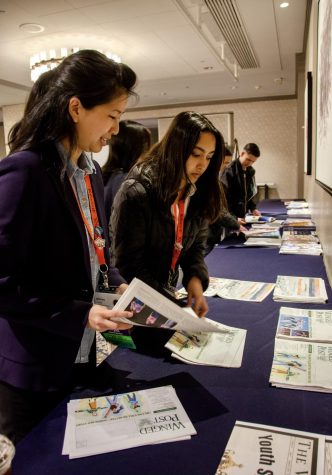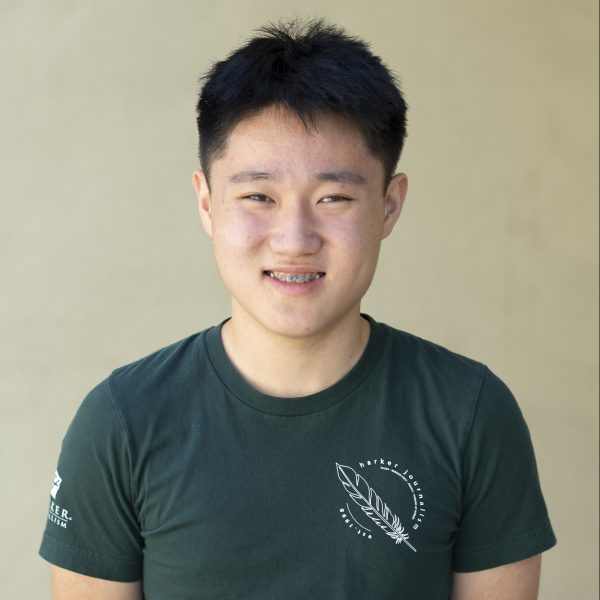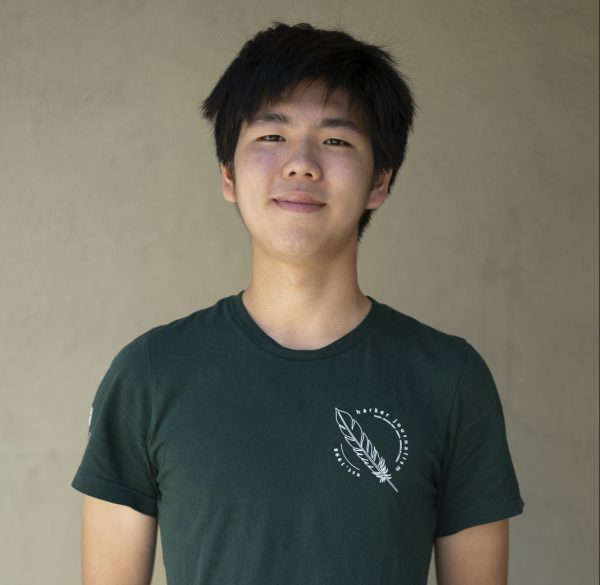History of high school journalism’s most historical convention
NHSJC breaks boundaries and forges new frontiers educating students in journalism
Students and advisors find seats at the NHSJC Opening Ceremony on Thursday night. The ceremony featured San Francisco Chronicle critic Peter Hartlaub, who spoke about uncovering truths and breaking stereotypes as journalists.
SAN FRANCISCO — Students and staff clad in bright orange lanyards fill the San Francisco Union Square Hilton, attending a culmination of the year’s achievements in high school journalism. Hailing from over 30 states, 3,000 young journalists participate in workshops about design, photography and videojournalism. They are attending the biannual National High School Journalism Convention (NHSJC), organized jointly by the National Scholastic Press Association (NSPA) and the Journalism Education Association (JEA).
With a history stretching back nearly 100 years, JEA was founded in 1924 and began hosting conventions twice a year starting in 1973. As a nonprofit organization, JEA writes a quarterly magazine that covers reporting, writing, design and more.
Over the years, JEA has grown and evolved considerably. In the last 10 years, adviser membership has increased from 2,019 in 2013 to 2,489 today.
Linda S. Putney, who served as the executive director of JEA from 1989 to 2010, saw this growth firsthand. At the time she started as executive director, the convention hosted a crowd of around 2,700, but by 2009, that figure was 6,353. This year, attendance is still recovering from the dip after the COVID pandemic.

Now retired, Putney still attended this year’s convention, where she handled speaker registration at the trade show.
“I still love to come to these conventions.” Putney said. “I’m still involved in the energy that [the students] bring to the convention and all the excitement. My passion is scholastic journalism, and I can still be part of that. And that’s really a ton of fun.”
Having seen NHSJC evolve over the years, Putney has continually brought her experience and expertise to the program, forging the convention into a hallmark of journalism education. Under her oversight, the program has become a defining feature of high school journalism, teaching tips and offering opportunities for student journalists nationwide.
As one of the only conventions catered towards high schoolers, NHSJC is in a league of its own, providing hope and inspiration for budding journalists. Associate professor at Midwestern State University Dr. Bradley Wilson has been involved with the program since 1988, helping out in activities ranging from judging photographs to teaching workshops. But his favorite part of the experience is meeting the students themselves.
“When I walk around and I see all the students being engaged and students having fun, and students getting experiences they’re just not gonna get anywhere else, I know [the future is] going to be fine,” Wilson said.
From a past deep-rooted in education to a future filled with promise, NHSJC now stands as an integral part of high school journalism enrichment. Putney reflects these aspirations for the program in future years.
“We have such a strong history and foundation for scholastic journalism, and the First Amendment, and I want us to keep that,” Putney said. “But I also want us to go forward so that we make student journalism viable and fresh and current.”

Jonathan Xue (12) is an Editor-in-Chief of Humans of Harker, and this is his third year on staff. This year, he looks forward to telling the stories of...

Grant Yang (11) is the co-academics editor for the TALON Yearbook, and this is his third year on staff. Grant is looking forward to designing his pages...

Kevin Zhang (12) is a co-managing editor for Harker Aquila, and this is his third year on staff. This year, Kevin hopes to expand the scope of sports content...


















![“[Building nerf blasters] became this outlet of creativity for me that hasn't been matched by anything else. The process [of] making a build complete to your desire is such a painstakingly difficult process, but I've had to learn from [the skills needed from] soldering to proper painting. There's so many different options for everything, if you think about it, it exists. The best part is [that] if it doesn't exist, you can build it yourself," Ishaan Parate said.](https://harkeraquila.com/wp-content/uploads/2022/08/DSC_8149-900x604.jpg)




![“When I came into high school, I was ready to be a follower. But DECA was a game changer for me. It helped me overcome my fear of public speaking, and it's played such a major role in who I've become today. To be able to successfully lead a chapter of 150 students, an officer team and be one of the upperclassmen I once really admired is something I'm [really] proud of,” Anvitha Tummala ('21) said.](https://harkeraquila.com/wp-content/uploads/2021/07/Screen-Shot-2021-07-25-at-9.50.05-AM-900x594.png)







![“I think getting up in the morning and having a sense of purpose [is exciting]. I think without a certain amount of drive, life is kind of obsolete and mundane, and I think having that every single day is what makes each day unique and kind of makes life exciting,” Neymika Jain (12) said.](https://harkeraquila.com/wp-content/uploads/2017/06/Screen-Shot-2017-06-03-at-4.54.16-PM.png)








![“My slogan is ‘slow feet, don’t eat, and I’m hungry.’ You need to run fast to get where you are–you aren't going to get those championships if you aren't fast,” Angel Cervantes (12) said. “I want to do well in school on my tests and in track and win championships for my team. I live by that, [and] I can do that anywhere: in the classroom or on the field.”](https://harkeraquila.com/wp-content/uploads/2018/06/DSC5146-900x601.jpg)
![“[Volleyball has] taught me how to fall correctly, and another thing it taught is that you don’t have to be the best at something to be good at it. If you just hit the ball in a smart way, then it still scores points and you’re good at it. You could be a background player and still make a much bigger impact on the team than you would think,” Anya Gert (’20) said.](https://harkeraquila.com/wp-content/uploads/2020/06/AnnaGert_JinTuan_HoHPhotoEdited-600x900.jpeg)

![“I'm not nearly there yet, but [my confidence has] definitely been getting better since I was pretty shy and timid coming into Harker my freshman year. I know that there's a lot of people that are really confident in what they do, and I really admire them. Everyone's so driven and that has really pushed me to kind of try to find my own place in high school and be more confident,” Alyssa Huang (’20) said.](https://harkeraquila.com/wp-content/uploads/2020/06/AlyssaHuang_EmilyChen_HoHPhoto-900x749.jpeg)



